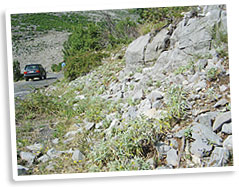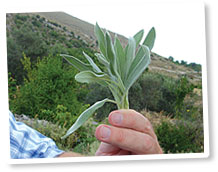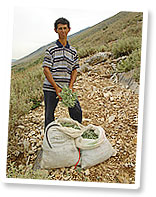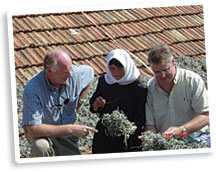Home | FOOD ARTICLES | Food Trivia | Today_in_Food_History | Food_History_Timeline | Recipes | Cooking_Tips | Food_Videos | Food_Quotes | Who’s_Who | Culinary_Schools_&_Tours | Food_Trivia_Quizzes | Food_Poems | Free_Magazines | Food_Festivals_and_Events
Food Articles, News & Features Section
FREE Magazines
and other Publications
Free Professional and Technical Research, White Papers, Case Studies, Magazines, and eBooks
SAGE FIELD REPORT
See also: Sage Trivia
Spice Buyer's Journal: Albania
In this installment of the Spice Buyer's Journal, Al Goetze, chief spice buyer at McCormick, reflects on his recent trip to Albania, where he inspected this year's developing sage crop.
Departing from Istanbul, I boarded the two-hour flight to Tirana, the capital of Albania, with my Turkish business partner, Kazim.

The majority of the world's sage (Salvia officinalis) grows wild in the mountains of Albania, Montenegro, Bosnia, and Croatia. This part of Europe has gone through tremendous change since the early 1990s. Once dominated by Communism, the region is now rapidly transitioning into a free economy, particularly in the agriculture sector. On this trip, we visited the major growing areas in the north and south of the country. These regions produce the best sage in the world.

To better understand sage, it helps to get a feel for the rough and rugged terrain in which it is grown. Albania is a small country - about the size of Maryland - that is made up of vast mountain ranges and sizeable fertile valleys. Its weather is temperate with mild winters and warm summers. As a result, it has one of the most diverse wild vegetative plant populations in all of Europe. On this trip, I learned that more than 250 botanical herbs naturally grow here. Sage, known in Albania as "sheradela," has been growing in the hill country for thousands of years. It grows best in elevations of 100 - 500 meters (300 - 1,500 feet).

On our first day, we traveled north to the town of Shkoder and worked our way into the Dalmatian Mountain range, traversing the steep sides of the hills on very narrow dirt roads. When we finally pulled over, we were treated to a magnificent, panoramic view. The mountains trail off to a valley that feeds into a large lake. This is spectacular scenery! Walking just a short distance from the road, we saw the silver-green sage plants growing wild, in every direction, among the rocks, grass, and scrub plants. It was also fascinating to see savory, oregano, thyme, and mint all growing wild in the same area.
Wild sage plants are actually quite small, compared to garden-cultivated sage. Each plant grows just 6 - 12 inches in height, and about the same in width. Unlike its cultivated cousin, wild sage is subject to whatever Mother Nature unleashes. Poor soil, too little or too much rain, and extreme heat are just a few of the conditions that the plant faces. While some plants might fade under that kind of pressure, these factors actually contribute to the herb's distinctive flavor and aroma.
On our second day, we traveled south to a small town called Berat, and headed up to the hill country to see the sage being harvested. The sun there is so hot, we had to wait to harvest the sage until late afternoon, when the mountain was shaded. We hiked up the very steep, rocky incline and met up with several of the villagers who harvest the sage. The harvest process is done completely by hand, using only a serrated sickle. While it is grueling work because the environment is so physically challenging, locals like the freedom of the job and the incredible views that come with the territory.
We hiked up the very steep, rocky incline and met up with several of the villagers who harvest the sage. The harvest process is done completely by hand, using only a serrated sickle. While it is grueling work because the environment is so physically challenging, locals like the freedom of the job and the incredible views that come with the territory.
They harvest several 100-lb. bags of fresh sage each day, and carry them to their homes to sun dry. One man I met has been harvesting sage for the last 30 years and is now introducing the trade to his daughter, who will carry on the family tradition.
One local villager joked that the lamb from this region eat so much sage, it actually makes the meat taste better. Here in the States, some of my favorite ways to enjoy sage are in recipes like Sage and Wild Mushroom Pork Chops and Cheddar Sage Potato Gratin.
About McCormick
McCormick was founded in 1889 in Baltimore, Md. Today it is the largest spice company in the world. McCormick sources only the finest ingredients from around the globe to bring the highest quality flavors to consumers. For more information, visit McCormick online at www.mccormick.com, or call 1-800-MEAL-TIP (1-800-632-5847).
RELATED ARTICLES
Please feel free to link to any pages of FoodReference.com from your website.
For permission to use any of this content please E-mail: james@foodreference.com
All contents are copyright © 1990 - 2025 James T. Ehler and www.FoodReference.com unless otherwise noted. All rights reserved.
You may copy and use portions of this website for non-commercial, personal use only.
Any other use of these materials without prior written authorization is not very nice and violates the copyright.
Please take the time to request permission.

